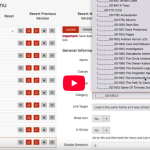
October 7,2021
Magento Open Source vs Shopify Plus Ecommerce (with examples scenarios)
When medium to enterprise businesses are looking for an e-commerce system that can grow with them, there are multiple options available. Two of the most popular are Magento Open Source (formerly Community Edition) and Shopify Plus they both have strong points, but as you’ll see below, they provide different end results and so a company’s individual needs should be considered before making the choice.
Important: Both Magento and Shopify have other software versions that we wouldn’t want you to get confused with. In this article, for Magento we are discussing Magento Open Source, not it’s enterprise version Magento Commerce (formerly Enterprise Edition), which is a separate system. For Shopify, we are discussing their exclusive Plus tier, not their basic shopping accounts (Basic Shopify, Shopify, Advanced Shopify). For this, the base monthly cost is a little over £1,500 per month.
You’ll invest a lot of time and money into your chosen system, so we want to help ensure you make the right choice. As we create websites in both systems, we’ve created this as an independent review.
We’ve looked at this from a business owners point-of-view and categorised the information using Functionality, Cost, Maintenance, Marketing and Control.
We’ve reviewed both Magento and Shopify native systems, however, both have a healthy ecosystem of extensions that can be added to extend their functionality.
| Magento Open Source | Shopify Plus | Verdict | |
| Functionality | |||
| Products | Magento has a range of different complex product types, these include simple, configurable, grouped and bundle. | Shopify has a simple set of product types, it has simple and configurable products. | Magento – More product options. |
| Product filtering and management | Magento has what are known as attributes, which can be used to split products by different elements, such as colour, brand, size etc. It allows you to add them to different types of data and manage these attributes at different levels. These can be used for filtering products on the front end of the website to improve navigation for users. | Shopify uses tags for differentiating products. You are able to add tags to products, which can be used for filtering products. | Magento – the set list of attributes you can use to set and split products gives you better control than tags. |
| Customers | Can create different customer groups which lets you have different pricing, discounts, and more depending on the group the customer is assigned to. | Can create tags that you apply to different customers that lets you offer different discounts depending on customer tag. | Magento – Deeper customer management, you can do more with customer groups than the tags in Shopify. |
| Multi-site | Magento has multi-site capabilities, you can manage multiple websites and products from one admin area. If you have the right infrastructure, there is no limit to the number of stores that can be created. | Shopify Plus allows users to create multiple stores and control them from one admin area. There is a max limit of up to 10 stores in total. | Magento – Just edges this one out as it does not have the limitation to the number of stores. |
| Payment gateways | Magento is integrated with Paypal, Braintree, Klarna, Amazon pay.You also have options for cash on delivery, cheque/money order, bank transfer, purchase order are a few of the options you have. | Shopify comes integrated with Paypal, Amazon pay and even it’s own payment method. You can also offer bank deposit, money orders and cash on delivery. Although you may be penalised for not using their system. | Draw – They both have a good choice of payment options available. |
| Shipping methods | By default, Magento lets you add a flat shipping rate, free delivery, table rates. It also has integrated with UPS, USPS, FedEx and DHL. | You can set up shipping profiles to set different delivery costs, depending on country, order weight and order price. You use box dimensions and package to create shipping costs. It has default integrations with UPS and FedEx. | Draw – They both come with similar defaults, and though Magento has more integrations by default, Shopify does offer certain options such as package size shipping methods, not available in Magento. |
| Magento Open Source | Shopify Plus | Verdict | |
| Maintenance | |||
| Hosting | Will require an additional cost, this will vary by supplier and on how much resources your website will use. It will also require someone with technical knowledge to manage. The minimum settings recommended by Magento are: MySQL 5.6, 5.7 Apache 2.4 2GB of RAM Supported PHP versions 7.1.3, 7.2.0, 7.3.0 | The Shopify Plus website doesn’t need an additional hosting cost. Part of the cost of having Shopify Plus is having it ready hosted on Shopify’s own platform. You can also have your Shopify website hosted elsewhere if you want. | Shopify – Despite the additional cost of being able to use the system, the fact that elements like hosting are taken care of by default makes it a lot simpler to get a Shopify website up and running. |
| Security updates | Update patches will need to be applied to Magento. These will need to be applied by someone with technical knowledge. | Security updates for the CMS are automatically applied. You will need to update plugins/extensions yourself and check compatibility with the version of Shopify you are using. You couldget ad hoc work done for any additional updates you need. | Shopify – The native system requires less effort to keep your CMS safe and secure. Draw – If you have other custom elements and extensions added. |
| Magento Open Source | Shopify Plus | Verdict | |
| Marketing | |||
| SEO Elements | Comes with the necessary base elements you need, title tag, meta description, canonical tags, set up custom redirects, robots.txt file. Pretty much everything you need can be done. | Shopify is more locked down around SEO. You do have access to elements such as meta details and title tags, but you can’t, for example, edit the robots.txt file. There are some workarounds for adding/editing canonical tags, hreflang references, noindex tags. | Magento – The greater control and range of functionality you have for managing the different SEO elements. |
| Discounts | Allows for complex discount creation. You have the option to have site discounts (see discount on product) and cart discounts (discount codes, meet certain criteria). These include set amount discounts, percentage based, buy X get Y and so on. And this is all set around various rules, from applying to specific products or categories to meeting certain hurdles like minimum order values or having specific items in your cart. | Shopify has a more basic discount options, these are split by discount codes and automatic discounts. You are able to pick between the type (percentage, fixed amount and Buy X get Y), what it applies to (entire order, collections, products). | Magento – It can do what Shopify does, plus more, allowing for more control of what you offer discount for. |
| Integrations | As of Magento 2.3, it is now integrated with Google Shopping Ads, allowing you to use the data to start running shopping ads. You can add more via extensions. | Shopify doesn’t come with any by default, and would need an extension to add the functionality. | Magento – With these being eCommerce systems, Google shoppings ads can be a major part of your marketing and having this as default in the system, means there’s no need to go out and get an additional extension. |
| Magento Open Source | Shopify Plus | Verdict | |
| Control | With a Magento website, you generally pay for it to be designed and developed, and once completed, you own what you have, you can take away the website to be managed by another company, you can export the data, you can control and adapt any part of the system. | Shopify is a closed system, once completed you do not own the site, you rent it. While you pay for it you can use their system. You could export the data (customers, products etc.) but you wouldn’t be able to take the design or website if you no longer wanted it. | Magento – As Magento is open source and on its own CMS, it means that once you have the website, it is yours to do what you wish. Shopify is based on a closed system, they retain control of the website |
| Magento Open Source | Shopify Plus | Verdict | |
| Cost | Magento Open Source system itself doesn’t cost anything, it is a free open source, however, you will need to have the website designed and developed, and the price will vary depending on the requirements of the website and the scale of the project. You’ll also need to have the website hosted and kept up to date when new updates are released (further details below). | Shopify has a monthly licence fee that starts at circa £1,500 per month and increases when you make around £610,000 of monthly sales. This cost increases to a maximum of £30,500 per month. On top of this it will need design and development work to build, which will vary depending on the agency you use and the scale of the project. Also, be aware that the agency you use will get a commission. | Draw – though Shopify has the additional recurring monthly cost that makes up a lot of the infrastructure, which will incur additional costs in Magento, such as hosting. |
As mentioned, adding extensions to either Magento or Shopify Plus can expand the base functionality product, we suggest you review your selection based on:
- Control
- Marketing
- Customisation requirements
- Future growth plans
So there are different scenarios where one might be a better choice than the other.
Shopify Plus might be the better solution if:
- You don’t need as many options or customisation for customers and only need a simpler product catalogue (now or in the future).
- If you want the infrastructure to be part of the website, so you don’t need to find and manage elements such as hosting and maintenance (note some maintenance may still be needed).
- If you want a clearer idea of what the cost of operating your website is each month.
Average Shopify Plus Starting Costs
- Setup £000’s dependant on your requirements.
- Example: Average low running costs from £1,500 per month (software).
Magento Open Source might be a better solution if:
- If you want more customisation and control over what you can do with your website, over elements such as products, customers and special offers now or in the future.
- You want more control over aspects such as the website SEO and marketing elements.
- Sell internationally or need microsites created from your central product database so visitors would see a separate ‘specialist’ website, but you manage it from one area.
- Prefer to own your website, rather than rent it.
Average Magento Starting Costs
- Setup £000’s dependant on your requirements.
- Example: Average low running costs from £800 per month (hosting & support).
What Magento & Shopify say
Below are pages from both Magento and Shopify where they highlight how their offerings are better than the alternatives. Not a perfect solution as they are not referencing like for like (Magento Open Source and Shopify basic to Advanced), but provides an idea where they are highlighting their strengths over the competition.
Magento say:
https://magento.com/solutions/magento-2-migration/magento-commerce-vs-shopify
Shopify say:
https://www.shopify.co.uk/compare/shopify-vs-magento
If you are not sure which solution is best for you or have any questions, get in touch with us by dropping us an email or call us on 01952 897444.




